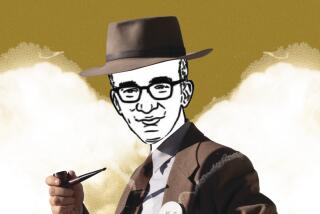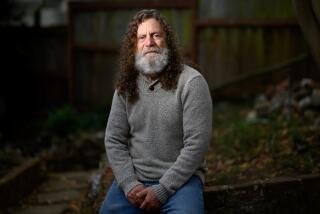BOOK REVIEW / SCIENCE : A Fascinating Stroll Through the Brain : CONVERSATIONS WITH NEIL’S BRAIN / The Neural Nature of Thought and Language <i> by William H. Calvin and George A. Ojemann</i> ; Addison-Wesley $24, 343 pages
- Share via
If you’d prefer not to scrutinize those warmly mystical feelings of deja vu and “eyes at the back of your head,” or if you’re disinclined to question the holy visions that strike others, then read no further.
For the “Neil” of this book’s title is an epileptic, and in explaining the nature of his seizures, neurophysiologist William Calvin and neurosurgeon George Ojemann ride roughshod over the sensations that we traditionally hold up as evidence of our special link with the sacred.
Those eyes at the back of our head, they tell us, are really just the “truly egocentric” neurons in Area 7 of the brain’s parietal lobe, which subconsciously decipher signals sent from the optic nerve to detect objects moving in the space just beyond our skin.
And that vision Paul had on the road to Damascus, they contend, was likely brought on by an epileptic seizure, the same electrical brain storm that may precede deja vu. Similarly, they reason, the voices that told Joan of Arc to save France may well have been auditory hallucinations with temporal lobe seizures brought on by tuberculosis, a disease that would explain the reason (calcific pericarditis) Joan of Arc’s heart refused to burn at the stake.
These explanations, appearing to invest our most sacred stories with all the artistic grandeur of a TV repair manual, may type the authors as rather unromantic and unspiritual souls. But Calvin, whose voice narrates this text (Ojemann serves as a sort of technical consultant), is in fact a “spiritual secularist,” a would-be Buddha with a mission for showing that science can evoke just as much wonder and instill just as much purpose as religion.
In his ambitious and successful “The River That Flows Uphill” (Macmillan, 1987), for instance, Calvin took his readers on a rafting trip in the Grand Canyon. While tossing rocks on a beach, he showed how the need for hand-eye coordination helped our brains develop; while gazing up at the stars, he explained how snow on the TV screen offers evidence of the Big Bang.
The fields for this outing--a hospital where part of Neil’s temporal lobe will be lopped off to cure his epilepsy--are considerably less Elysian.
Calvin, nevertheless, does his best to evoke the scenery (“Neil and I had the round table to ourselves, amid the smell of fresh coffee and the sound of rain on the glass roof”) and his literary device (“Neil” is a composite of many patients) occasions great dialogue. After the operation, for instance, a baseball-capped Neil greets his two doctors:
Neil: “Well, I guess I gave you a piece of my mind!”
Calvin (groaning): “No, only a piece of brain. Anatomy. The mind is the brain in action, its physiology. Mind is like what the computer produces, rather than the computer itself.”
Neil: “Now, if it were my computer, knocking out a piece of it would cause it to crash. And it could never reboot itself. . . . I think the analogy you want is not a computer, but rather a computer network. One that can share work among the idle processors. You ought to figure out how the brain can reorganize itself . . . then patent it quickly, before a computer designer does!”
Ojemann: “Except for the little problem that we don’t know enough about how the brain works.”
Calvin: “The usual hyperbole, even repeated by the New York Times in a headline, is that the principles they use are ‘based on the human brain’ . . . . Which is a gross overstatement. . . . A more appropriate headline, considering the current state of the art, would have been ‘based on slug nerves.’ ”
Calvin’s decision to organize this book around an operation to cure epilepsy does have a big drawback: Such an operation must focus on charting speech and thought areas so as not to excise them along with diseased brain tissue. The brain, however, is such a Byzantine brier of neurons that not even a cartographer as skilled as Calvin can offer a map that lay people can decipher.
Thus the best parts of this book are the more philosophical ones, wherein Calvin concedes that human thought is best understood as “a process, not a place.”
Calvin is too modest to reveal that the theory currently favored for explaining that process--neural Darwinism--is one that he helped fashion. Nevertheless, he explains the process lucidly as a kind of game in which our subconscious chooses among competing networks of neurons--each one offering its own way of interpreting perceptions by summoning up specific memories.
The winning “neural network” gets to weave our story for the day--a story we call “consciousness.”






